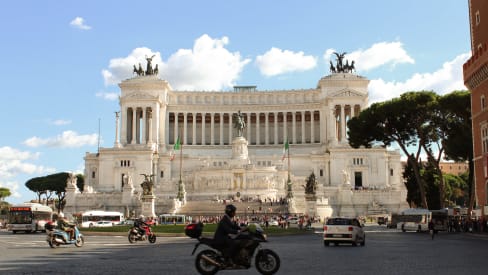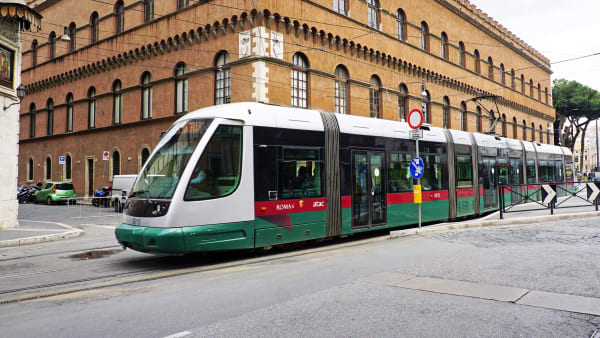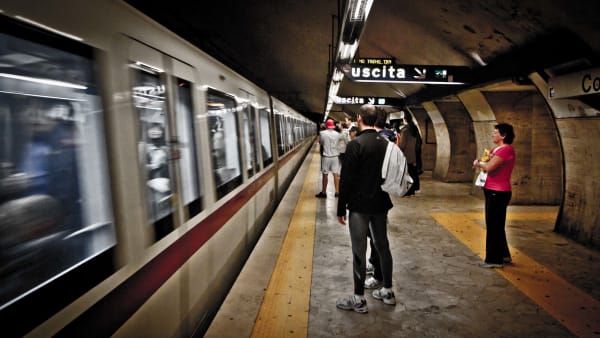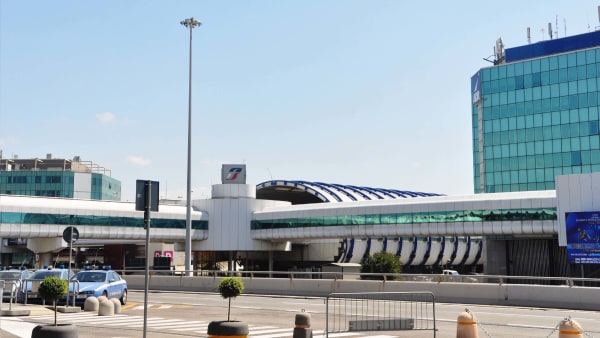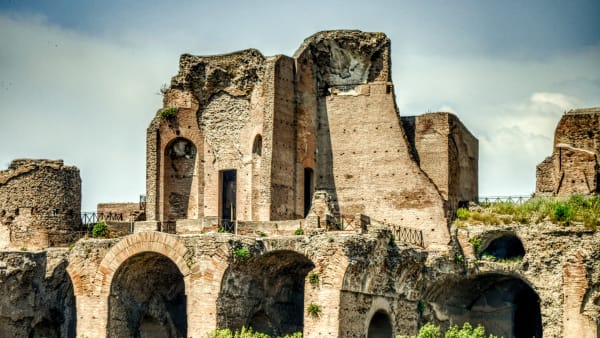Buildings and monuments
Buildings and monuments
As mentioned, the square is full of majestic buildings, monuments, and works of art dating back to different time periods in the history of Rome. Some of the most relevant have been named in the historical section and will be talked about in more detail in this section.
Venice Palace
This building is one of the reasons why the square came to be known as a tourist site after fascism. This is because the Palace is not only a magnificent building, but it also hosts the Museo Nazionale del Palazzo di Venezia (National Museum of the Venice Palace) and the Istituto Nazionale di Archeologia e Storia dell’Arte (Archaeology and History of Art National Institute).
With its stern appearance, three tiers of windows, cornice crenellations, and an impressive tower, the building is considered one of the most significant civil works of the 1400s in Rome, as well as the first construction of this size built in the early Roman Renaissance.
It was the house of a Venetian Cardinal, Pietro Barbo (who later became Pope Paul II), who had it built between 1455 and 1464, using travertine from the Colosseum and the Marcello Theatre. The building was later expanded by Pietro’s nephew, cardinal Marco Barbo. It acquired its final and current appearance thanks to cardinal Lorenzo Cybo. The Palace became a residence for the Saint Mark cardinals, as well as a papal residency.
In 1564, Pope Pius Medici IV donated the Palace to the Republic of Venice, and it later became its embassy until 1797. As mentioned above, this is where the building’s name comes from.
Between 1567 and 1797, the diplomatic venue hosted renowned figures, like Borso d’Este Duke of Ferrara, the King of France Charles VIII, and the sculptor Antonio Canova. In 1715, ambassador Nicolò Duodo decided to carry out the renovation works that included the balcony overlooking Piazza Venezia. This was the unfortunate balcony that, at the beginning of the XX century, became the symbol of fascism.
Another honorary guest staying at the Palace in 1770, was the incredible Wolfgang Amadeus Mozart. At the time, he was 14 years old and performed in the so-called Sala del Concistoro.
After the Treaty of Campo Formio in 1797, and with the fall of the Republic of Venice (known as La Serenissima), the palace became the property of the Austrian Empire and kept its function as diplomatic headquarters.
Between 1806 and 1814, under the brief Napoleonic domination, the structure fell in disuse, to the point that the courtyard started to be used as a marketplace. Afterward, between 1814 and 1916, it hosted Austro-Hungarian representatives.
In order to bring the Palace back to its ancient glory, the architect Anton Barvitius carried out renovation works. The current location of the building was determined by the plans made during the reconstruction of Piazza Venezia, at the time the Vittoriano was built.
In 1916, the Italian Kingdom claimed the Palace for its patriotic and meaningful role. The monumental staircase, designed by Luigi Marangoni, is one of the most important works celebrating the Unification of Italy and the areas taken from Austria in the Third Independence War (1866) and in WWI (1915-18).
To the right of the building, almost at the corner with Via del Plebiscito, there is a small chapel dedicated to the Madonna delle Grazie, commonly known as Madonnella of St. Mark, dating back to 1699.
Between 1929 and 1945 this palace acted as Seat of the Head of Government and the Great Council under Fascism. Today instead, the palace houses the National Museum of the Palazzo di Venezia and the Library of Archaeology and History Of Art.
The Museum of Palazzo Venezia
Since December 2014, the Museum has been property of the Ministry of Cultural Heritage and Activities, together with the Library of Archaeology and History of Art.
The painting collection includes masterpieces from the XIII to the XVIII century. Among these, we can find the Annunciation with two Kneeling Donors by Filippo Lippi, as well as works by Giotto Beato Angelico, Giorgione, Benozzo Gozzoli, Guercino, Pisanello, Guido Reni, Giorgio Vasari and Gian Lorenzo Bernini.
In the outside loggia, we can find a lapidary. Important collections are kept in the Museum, among these, we can find collections of harms, tapestries, coins, fabrics, medals, glass, silver, and wooden structures. The ground floor is dedicated to distinguished exhibitions.
Assicurazioni Generali Palace
Marco Besso was the one to want the realization of the Assicurazioni Generali Palace, being the director and later president of the company itself. The company decided to have its headquarters in the heart of Rome, near Trajan’s Column and the Imperial Fora.
The Palace replaced the Torlonia family building, occupying the same area. Giuseppe Sacconi, its architect, who also designed the new Piazza Venezia, wanted to mirror the aesthetic features of the Palazzo Venezia.
For this reason, many claim that the structure is just architectural forgery, as it imitates a renaissance building. This was because, after the construction of the Vittoriano, between the 1890s and the early 1900s, the architect wanted to build two symmetrical backdrops to the King’s monument, thus maintaining the symmetry of the square.
The design of the Palace was then prepared by Arturo Pazzi, Alberto Manassei, and Guido Cirilli, integrating the elegance and harmony of the Venice Palace, even re-proposing the same square tower and the height of the building.
The building was constructed between 1906 and 1911. It has a trapezoidal plan, arranged around a vast courtyard with a portico decorated with stucco and graffiti, with the function of a court of honor typical of Renaissance palaces.
The Bonaparte Palace
The last side of the square is occupied by the Bonaparte Palace, one of the historical buildings of the area, built between 1657 and 1667 by Giovanni Antonio De Rossi for the D’Aste family.
It was later purchased by the Rinuccinis, who bought it for its marvelous architecture, and in 1818 it went to Letizia Ramolino, mother of Napoleon Bonaparte I. She lived here even after her son’s fall, until the final days of her life, in 1836.
In 1905 then, the structure went to the Misciattelli family, but it is still known to this day as Bonaparte Palace. Since 1972 it has been the property of Assitalia. After the renovation works in 2019, the building has been opened to the public and it hosts exhibits and events. One of these was in 2020, where 50 masterpieces by Camille Pissarro e Claude Monet were exposed.
The most eye-catching elements of the Palace are surely the Baroque architecture and the frescos dating back to the ‘700. It also has a small mansard overlooking three rows of windows with uneven gables.
The façade consists of three floors, each with five windows, where the gables differ in design. Those on the second floor have curved tympanums and a lion, representing the symbol of the first owners, the D’Aste family.
The first floor features a covered corner balcony, one of the few still surviving, called bussolotti or mignani, and a belvedere at the top on which Bonaparte is written. It is said that here Letizia Bonaparte spent entire days sitting behind the covered balcony watching the Romans walk by.
Saint Mark Basilica
Incorporated into Palazzo Venezia (it is its Palatine Chapel), the Basilica was built in 336 A.D. by Pope Mark in honor of Saint Mark the Evangelist. It was later rebuilt in 833 by Pope Gregory IV, who decorated the apse with delicate mosaics, still present to this day. The bell tower was added in 1154.
The façade was then altered, according to Renaissance taste, with arches and a blue ceiling. These significant alterations were requested by Pope Paul II in 1465-1470.
The Pope, being of Venetian origins, had the ceiling of the central nave adorned with the emblem of Paul Barbo II, and dedicated the church to the Venetian community in Rome. In the interior, the Basilica seems to be medieval and features Leonardo Pesaro’s tomb (son of an ambassador), sculpted by Antonio Canova.
The current appearance took shape in three phases, between 1735 and 1750, following some demanding works commissioned by cardinal Angelo Maria Quirini, based on an idea by Filippo Barigioni.
At the time of the Vittoriano’s construction, the Basilica, like many other buildings, saw some alterations. Between 1947 and 1949, some works to reduce humidity in the building were carried out, the crypt was reopened and renovated.
There remain a few traces of the initial structure, due to the various works sponsored by the aforementioned Pope Barbo. The façade, built using travertine material from the Colosseum and the Marcello Theatre, consists of a three-arched portico on half-columns with composite capitals and a loggia with pilasters with Corinthian capitals.
The Romanic bell tower dates back to the XIl century, while the access portal is from the 1550s. The interior lost many of its Renaissance characteristics under the heavy decorative style of the 1600s and 1700s.
The interior, divided into three naves, the most admirable work is found in the apse, where the 9th-century mosaic depicts Christ with St Mark the Pope and Saints Agapitus, Agnes, Felicissimus, Mark the Evangelist, and Gregory IV; below, Christ and the Apostles.
There is a funerary monument by the side entrance, work by Antonio Canova. On the sacrament altar at the end of the nave, we find Saint Mark the Pope, by Melozzo da Forlì. Meanwhile, the body of the saint is kept in a porphyry urn in the presbytery. Finally, the sacristy preserves the remains of the original ciborium, precious furnishings, and reliquaries as well as a fragment of a 13th-century Crucifixion.
The Monument to Vittorio Emanuele II or Vittoriano
The National Monument to Vittorio Emanuele II or Vittoriano, also called Altar of the Fatherland is a complex national monument standing on the northern edge of Campidoglio Hill. It is located in the heart of ancient Rome and connected to modern Rome thanks to a number of streets that radiate out of Piazza Venezia.
The Vittoriano was designed and built by Ettore Ferrari, Pio Piacentini and Giuseppe Sacconi. The latter was a young architect from the Italian region of Marche, who in 1882, won the competition held to design a monument celebrating the death of Victor Emmanuel II.
Construction began in 1855 and concluded in 1935. However, the official inauguration and opening to the public happened in 1911, during the International Turin Exhibit, celebrating the 50th anniversary of the Italian Unification.
Sacconi decided to represent the themes of the fatherland and unification, both allegorically and geographically. We can therefore find the sculptural groups of Thought, Action, Harmony, Strength, as well as the Tirreno and Adriatico fountains (two seas to the east and west of Italy), as well as the Unity and Freedom Quadrigas, watching over the regional statues from above.
From an architectural point of view, it was conceived as a modern forum, an agora on three levels, connected by staircases and topped by a colonnaded portico. It also features the Altar of the Fatherland itself. It initially consisted of an altar of the goddess Rome, and later also that of the Unknown Soldier (Milite Ignoto in Italian), which will be analyzed more in-depth in the Curiosities section.
The monument was built in white botticino marble, instead of travertine, as originally planned. Inside, we find showrooms dedicated to the history of the Vittoriano itself. Other areas are the Sacrarium of the Flags and the main venue for the Risorgimento Central Museum, which traces the path that led to the Unification of Italy and often hosts interesting exhibitions. Risorgimento (Resurgence, in English) is the Italian term used to refer to the period and cultural movement surrounding the Unification of Italy, not to be confused with the term Renaissance, Rinascimento in Italian.
The whole monument was given a strong symbolic value, representing sacrifice for the fatherland and other related ideals. The figure of Vittorio Emanuele II of Savoy and the Altar of the Fatherland come to symbolize the complex process of national unity and liberation from foreign domination. The whole place can be defined as a secular temple in honor of a free, united, and celebrating Italy.
From its inauguration, the Monument has hosted many important celebrative events, of course, this has reinforced its function as a symbol of national identity. The main annual events are the Anniversary of the Liberation of Italy from the Fascist Regime (25th April), Republic Day (2nd June), and the National Unity and Armed Forces Day (4th November).
In these last celebrations, the President of the Republic and the highest offices of the State pay their respects to the Church of the Unknown Soldier, in memory of the dead and missing in action.
After the closure of almost 30 years, from 1969 to 1997, there was a revaluation of the whole complex of the Vittoriano, which is now perceived as an example of art from an early Unified Italy, a fusion of a splendid fusion of Art Nouveau, Eclecticism and Neoclassicism.
In front of the Church of Saint Mark, we can find the Fountain of the Pinecone. It symbolizes the neighborhood of the same name, and it is one of ten similar fountains built in Rome between 1925 and 1927 (one for each neighborhood). It consists of a small basin with a central stem. Here, two highly stylized corollas support a pine cone; the water comes out of two lateral spouts and pours into basins on the ground, surrounded by four barriers.


